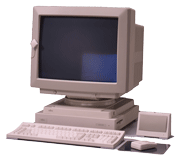The Fujitsu S-4/10 workstation was equipped with a 32-bit SuperSPARC microprocessor. Fujitsu announced the S-4/10 models 30, 40, and 50 in May 1992. The machines were supplied by Sun Microsystems, headquartered in the U.S., on an OEM basis.*1 PFU also sold the same models. The Fujitsu S-4/10 models corresponded to Sun Microsystems’ Sun SPARCstation 10 and Sun SPARCserver 10.
As IT usage became more open, it was important to ensure an increasing number of applications could operate on a given computer. For this reason, Fujitsu used Sun Microsystems products, which ran a wealth of global applications, to beef up its line of S Family Engineering Workstations (S Family). Fujitsu also rolled out the F6788C and F6788D Japanese language page printers to strengthen its peripheral device lineup for the Japanese market
- *1. Fujitsu completed an OEM agreement with Sun Microsystems in August 1988 and in the same month announced the Fujitsu S-3/4 workstation family as the S Family for the engineering workstation (EWS) market. In this way, Fujitsu incorporated the latest industry standards and addressed the EWS market, which was undergoing tremendous growth at the time.
| Model | S-4/10 30 | S-4/10 40 | S-4/10 50 | ||
|---|---|---|---|---|---|
| Introduced | May 1992 | May 1992 | May 1992 | ||
| CPU | SuperSPARC | ||||
| No. of CPUs | 1 | 2 | 4 | ||
| Performance | SPECint92(*1) | 44.2 | 52.6 | -- | -- |
| SPECfp92(*2) | 52.9 | 64.7 | -- | -- | |
| SPECthrput89(*3) | -- | -- | 109 estimated | 218 estimated | |
(*1) SPECint92: An index indicating a machine’s integer computation performance.
(*2) SPECfp92: An index indicating a machine’s floating point computation performance.
(*3) SPECthruput89: An index indicating a machine’s multiprocessing performance.
The specifications above were correct at the time the products were announced. Some specifications were later revised due to product upgrades.


